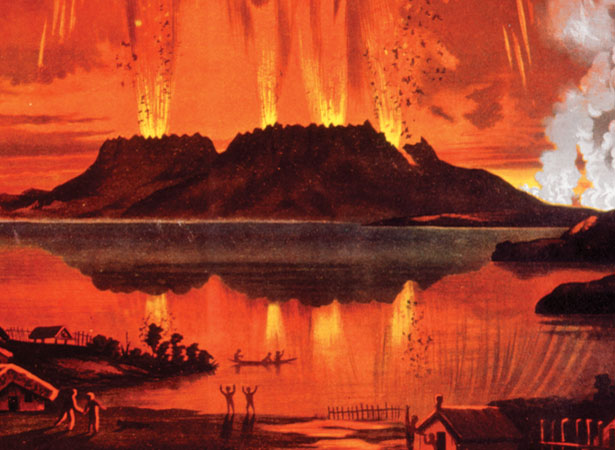
The eruption lasted six hours and caused massive destruction. It destroyed several villages, along with the famous silica hot springs known as the Pink and White Terraces. Approximately 120 people, nearly all Māori, died.
In the early hours of 10 June, locals awoke to earthquakes, lightning, fountains of molten rock, and columns of smoke and ash up to 10 km high. People as far away as Blenheim heard the eruption. Some thought it was an attack by a Russian warship.
A 17-km-long rift split Mt Tarawera and extended as far south as Waimangu. The eruption covered land with millions of tonnes of ash and debris, transformed lakes, and flattened bush. It was over by dawn, though ash made day as dark as night. Men from Rotorua and Ōhinemutu formed rescue parties and began digging out survivors and casualties. Settlements at Te Tapahoro, Moura, Te Ariki, Totarariki, Waingongongo and Te Wairoa were destroyed or buried. Te Wairoa, now known as ‘The Buried Village’, later became a tourist attraction.
Watch the Tarawera television documentary (NZ On Screen):
Read more on NZHistory
Scenery preservation in New Zealand – Scenery preservation 1903-1953New Zealand disasters timeline – New Zealand disasters timelineThe Pink Terraces – History of New Zealand paintingThe White Terraces – Scenery preservation 1903-1953The eruption of Mt Tarawera - roadside stories – New Zealand disasters timelineHistory of New Zealand, 1769-1914 – A history of New Zealand 1769-1914
External links
- Painting of the eruption (National Library)
- The Tarawera eruption (Te Ara)
- Historic volcanic activity (Te Ara)
- Disasters and mishaps (1966 encyclopaedia)
- Tarawera phantom canoe (1966 encyclopaedia)
- Memorial to Edwin Bainbridge (Flickr)
- Tarawera doco (NZOnScreen)
- White Terraces rediscovered (GNS Science video)
How to cite this page
'Eruption of Mt Tarawera', URL: https://nzhistory.govt.nz/eruption-of-mt-tarawera, (Ministry for Culture and Heritage), updated 17-Jul-2023

Community contributions